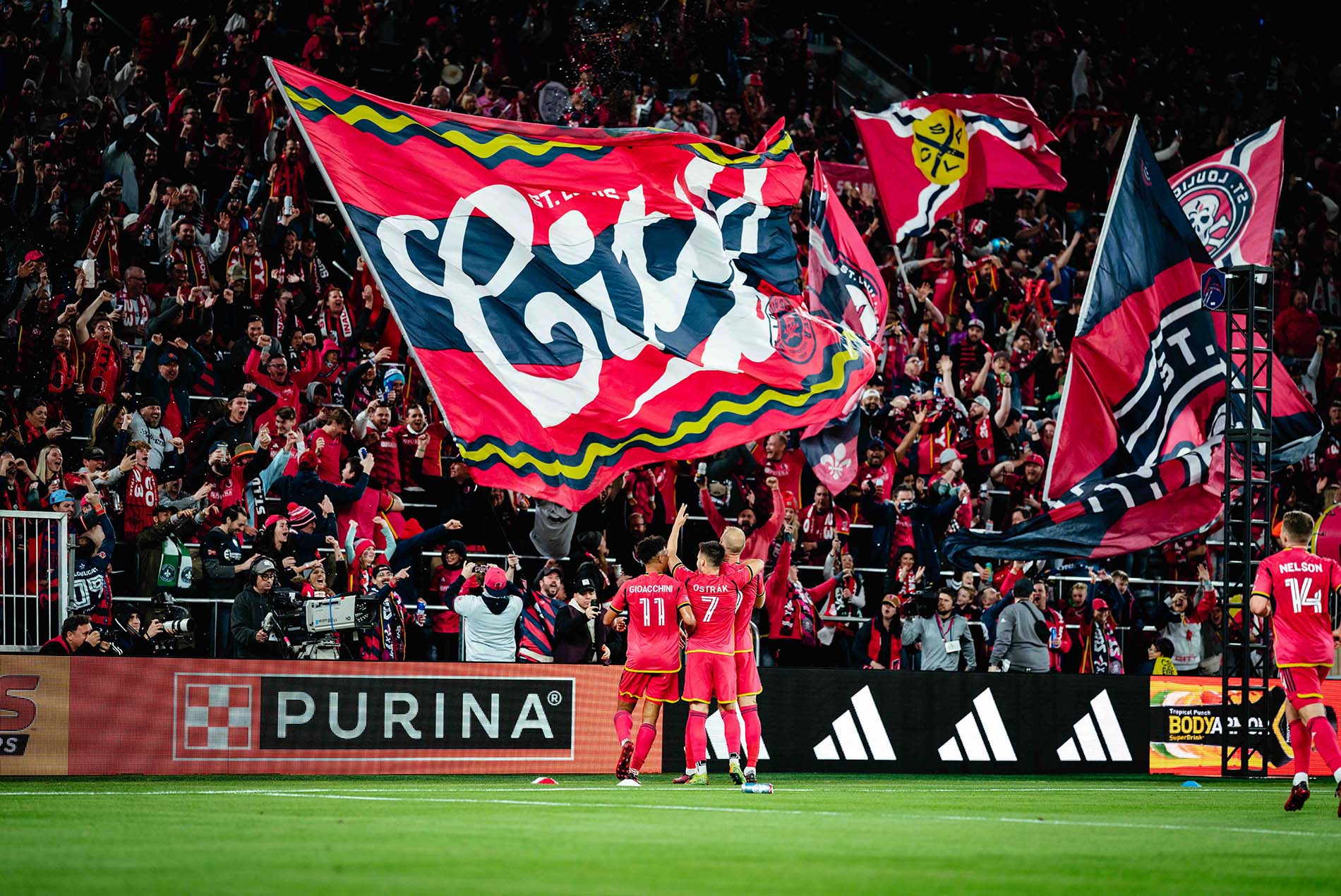The Romans understood the art of the spectacle. Think back nearly two millennia ago and imagine the Colosseum, the Romans’ great amphitheater, buzzing with the excitement of tens of thousands of spectators. Its groundbreaking tiered seating arrangement ensured they all could see the games.
While today’s contests are less literal than the gladiatorial battles of old, the challenges of designing the perfect sports venue remain remarkably similar. Architects are still trying to answer the same fundamental questions: How do we perfect sightlines? How do we maximize spectator capacity without jeopardizing safety? How do we engineer the acoustics to amplify the crowd’s roar, creating an electrifying atmosphere that unifies fans?
HOK’s Sports + Recreation + Entertainment group architects Jon Maxey and Tyler Clark have embraced these challenges. They’re at the forefront of shaping modern seating bowl design, navigating the intricacies of engineering, fan preferences, safety and shifting market trends to deliver today’s equivalent of the grand Roman spectacle.
Could you walk us through the initial process of designing a seating bowl for a new client?
Jon: We start by identifying the sport for which the seating bowl is intended. If the venue will host multiple types of sports, the design parameters change. The placement of the first row in an American football stadium, for example, varies greatly from that of a soccer stadium. Hockey and basketball also come with their own unique requirements.
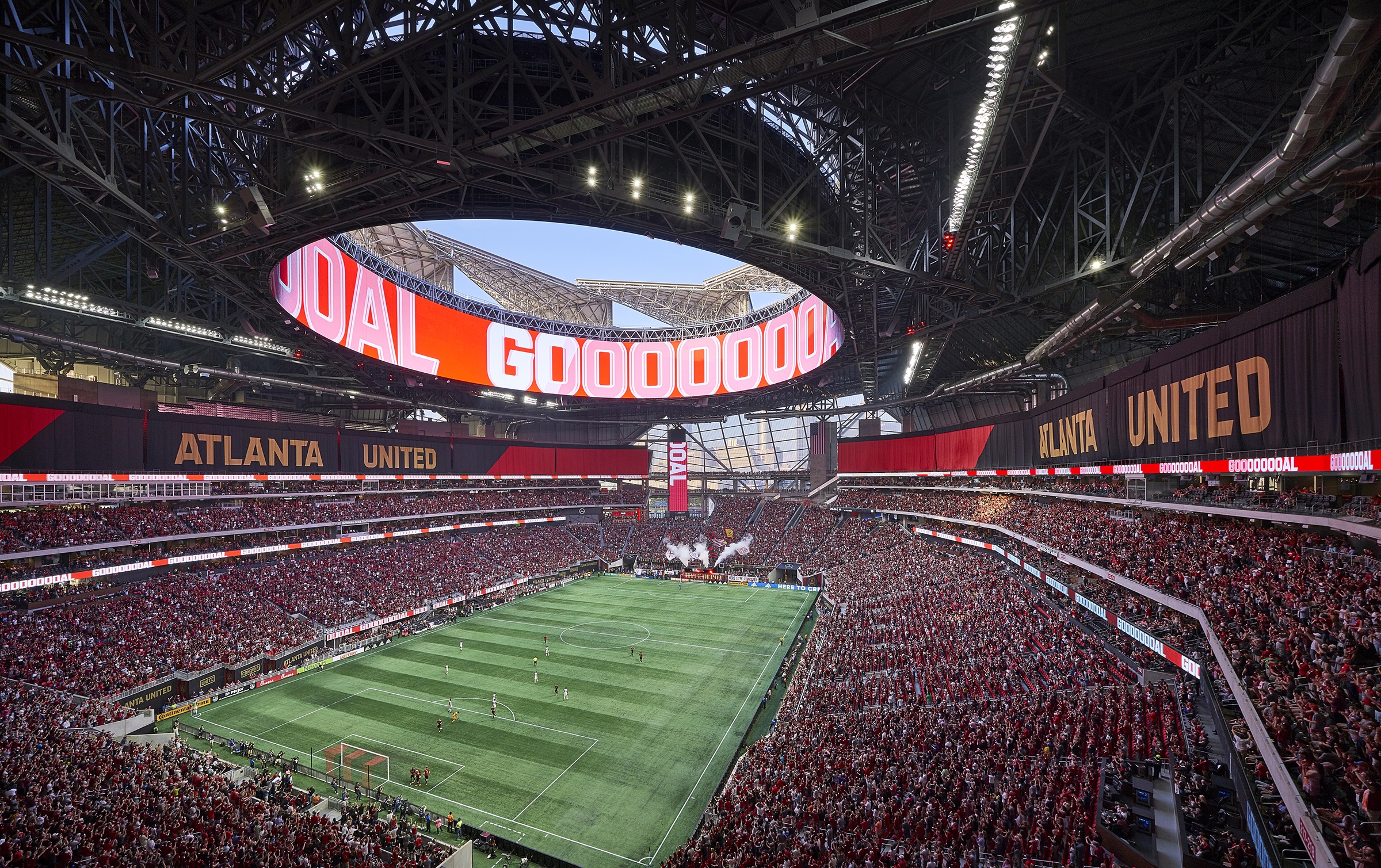
The seating bowl at Mercedes-Benz Stadium in Atlanta was designed to accommodate MLS and the NFL.
Tyler: We encountered this when designing Mercedes-Benz Stadium. It was originally intended only for the NFL, but the ownership group was awarded the Atlanta United FC MLS expansion team in 2014. This required us to modify the seating bowl, as soccer fields typically occupy larger dimensions than football fields. Despite this change, we were still able to maintain its remarkable atmosphere and intimacy. A similar situation occurred with Detroit’s Little Caesars Arena, which was originally designed for hockey but later had basketball added to it. These dual-purpose venues can offer many benefits to the community, but do require some creativity in seating bowl design to ensure they serve as exceptional venues for multiple sports.
Our St. Louis CITY SC MLS client wanted Energizer Park to be a soccer-only venue. This gave us great freedom in our design process. The result is an inviting, transparent seating bowl accommodating 22,500 fans. Fans enjoy unobstructed city views from their seats, while passersby get a glimpse of the on-field action. Positioning the field 40 feet below street level enhances the pedestrian-friendly scale and integrates the stadium into its downtown neighborhood. Little Caesars Arena took a similar pedestrian-friendly approach with a sunken seating bowl.
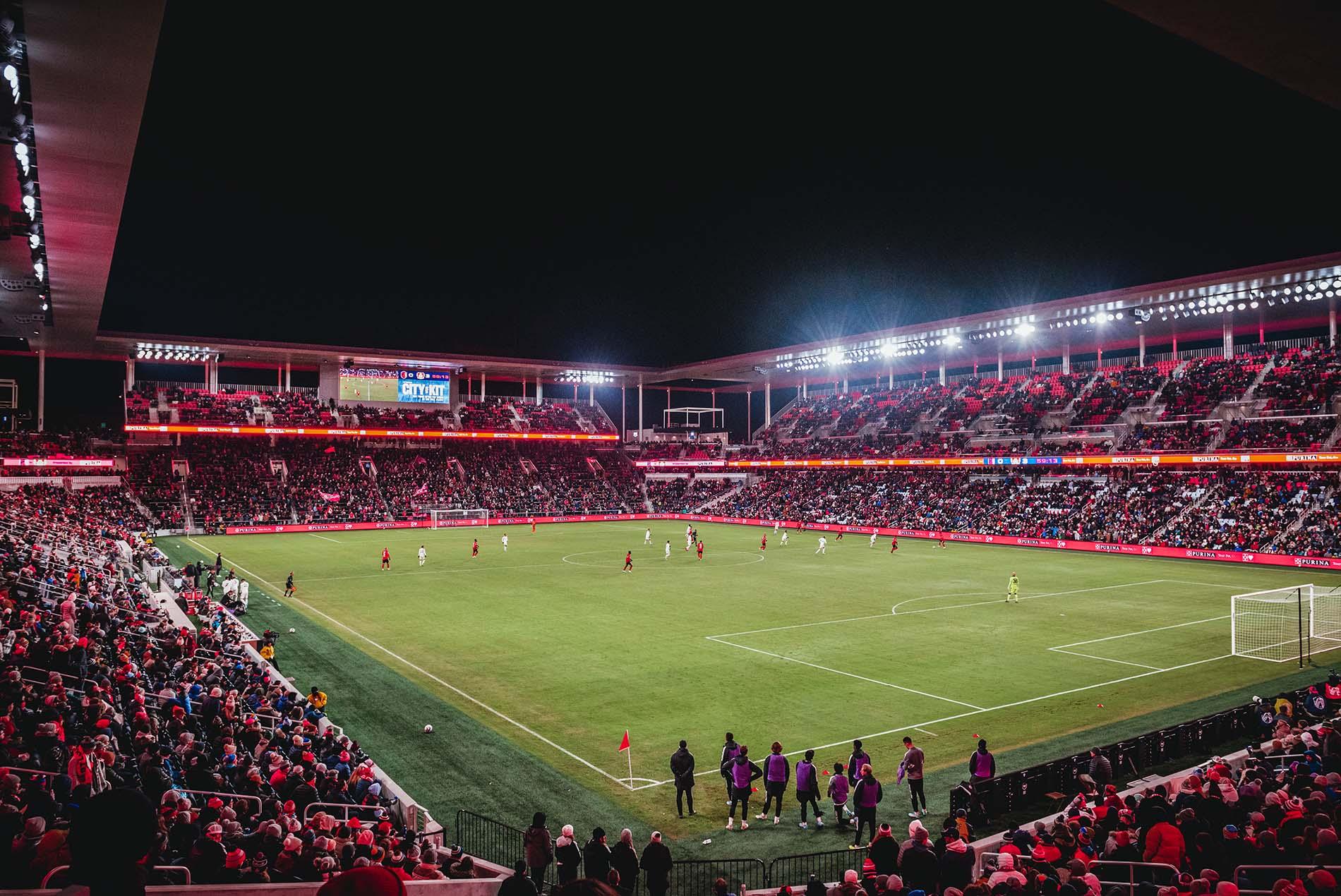
The pitch at Energizer Park sits 40 feet below street level, creating a pedestrian-friendly and intimate seating bowl. Photo credit: St. Louis CITY SC
Jon: Once we have clarity on the sports we need to design for, we focus on the venue’s focal point. It could be the edge of a court, an end line or another notable feature, or an imaginary point possibly elevated off the floor or field. This focal point serves as the foundation for our design.
Next, we consider factors like the client’s desired seating capacity, site constraints, special features or requests, the number and size of luxury suites, and the implications of club seating.
Stadium owners often come to us with ideas about capacity and premium features, informed by their own market research and league comparisons. They may also have data from companies like CSL, suggesting the maximum number of a specific type of seat they can sustain. Our role is to marry these parameters with the seating bowl design.
How does the physical site of the venue influence your approach to balancing an intimate fan experience with maximizing seating capacity?
Jon: In some projects, we adopt a reverse engineering approach, determining the maximum number of seats that can be accommodated at the steepest rake—or incline of the seating area from the field outward—we’re willing to construct. This dictates how close we can get to the field. But specific capacity requirements sometimes prevent us from achieving optimum intimacy. So, it becomes a back-and-forth exercise where we continuously fine-tune the stadium’s section and reconcile it with the site and capacity constraints.
Tyler: We are constantly seeking a balance between the intimacy of the first-row experience and the external constraints imposed by the site. The key lies in defining the internal boundary—consisting of the playing field, its sightlines and the height of the first row—and then determining how much further we can extend based on external factors and the overall seating capacity.
Sometimes, the site boundaries influence the seating bowl footprint. These tight, urban sites can actually lend to creative solutions and enrich the design—like an upper bowl with a chamfered corner that elevates fans and brings them closer to the field.
How does a client’s request for an intimidating bowl experience shape your design approach?
Tyler: A key consideration for Energizer Park in St. Louis was the proximity of seats to the field. We tried to immerse the fans in the action by designing an overhanging upper bowl that brings them closer to the field. The steepness of the seating layout heightens the atmosphere. In the supporter section, we pushed the boundaries by designing an even steeper rake that directs everyone toward the field and creates an intimidating wall of fans behind the goal. For MLS, this approach is a departure from the more relaxed atmosphere of the single sweep bowl design of a decade ago.
Jon: We used a similar approach in Little Caesars Arena. We stretched the design parameters to create a fairly steep bowl. The corners in that arena also presented unique opportunities since they don’t demand a straight sightline. By exploring these areas in 3D, we were able to design options that allowed us to tighten the corners. Whatever the sport, we aim to bring spectators as close as possible to the action.
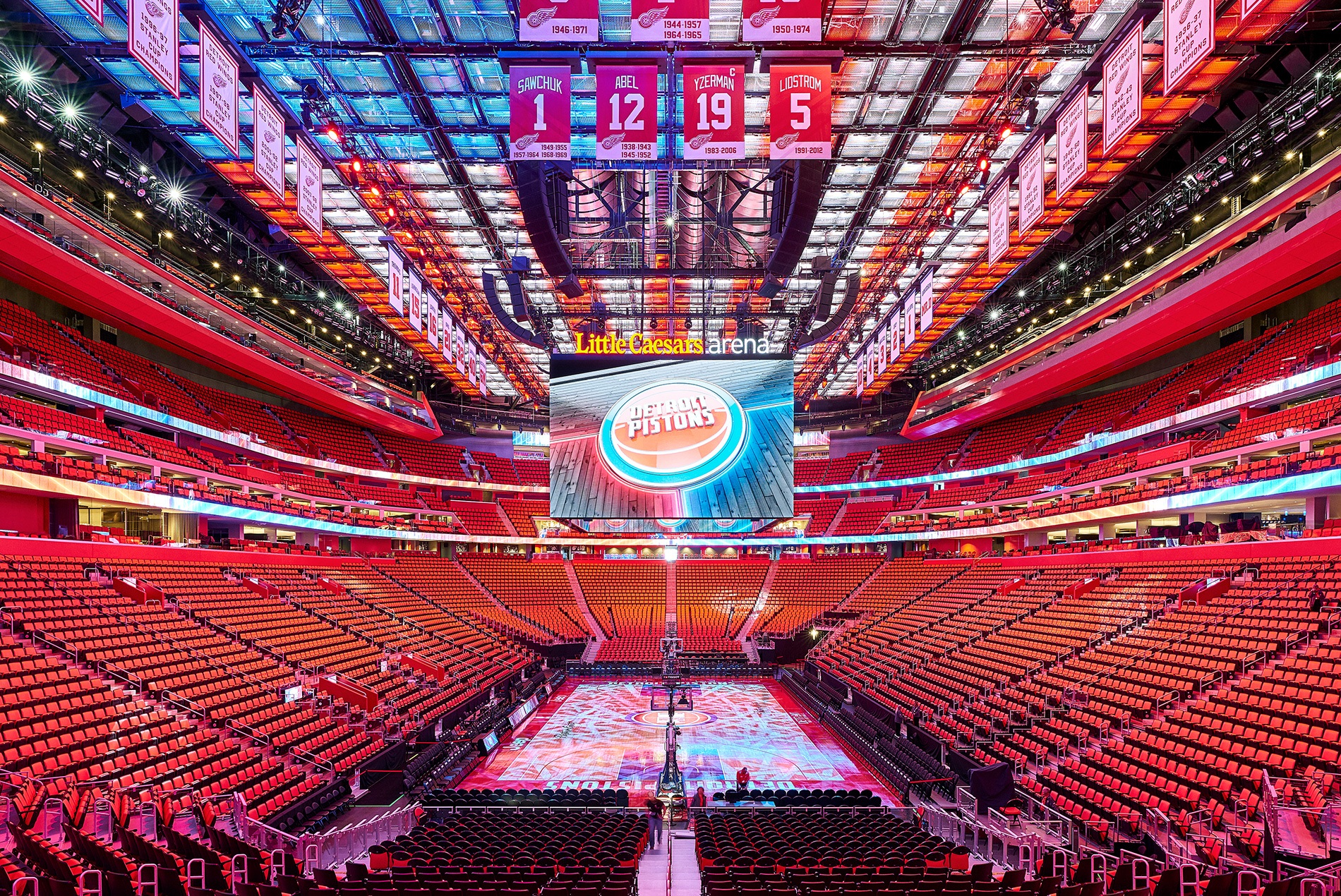
Detroit’s Little Caesars Arena boasts an intimidating and intimate seating bowl because of the rake of the seats, amplifying noise and bringing fans on every level close to the action.
As you attempt to provide an immersive fan experience, how do you ensure that both player safety and game integrity aren’t compromised?
Tyler: Each sports league sets specific guidelines dictating the space around their field or court. MLS, for example, suggests a maximum steepness for the rake. But there’s room for dialogue around these parameters. We often have conversations with league officials if we propose a slightly different idea. They recognize our expertise and know we’re advocating for the best outcome, with player and fan safety as the priority.
Jon: The increasing demand for specialized seating areas closer to the action also impacts gameplay. In the NBA, we see players falling into expensive courtside seats. In Major League Baseball, the space behind home plate has reduced from around 50 to 60 feet in some stadiums to 45 feet or less, allowing for additional rows in the front area. This move not only impacts the fan experience, but can impact the game as a catcher now has less ground to cover when chasing down a pop foul or wild pitch.
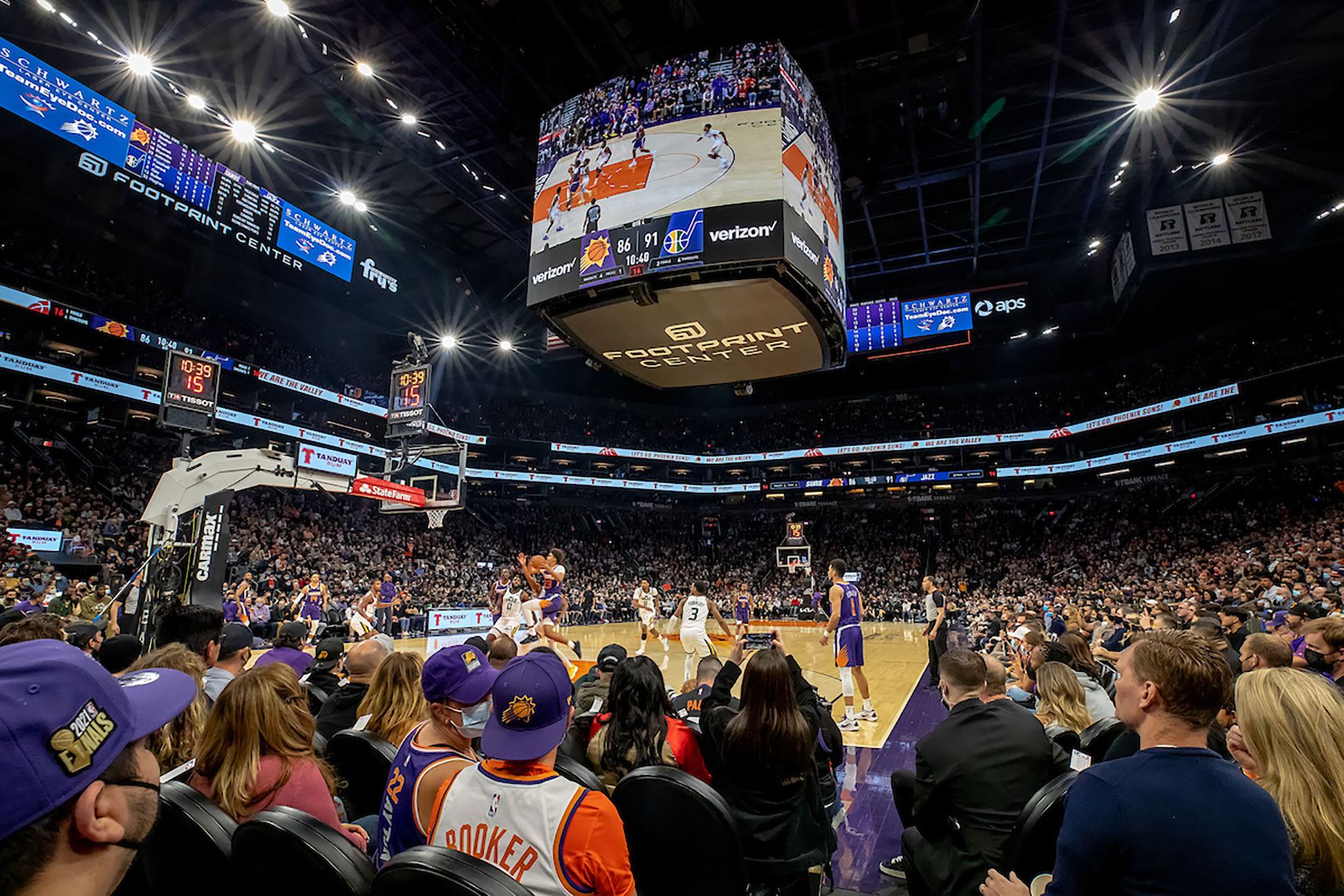
At Footprint Center in Phoenix, fans in courtside seats get as close to the action as possible.
How have your seating bowl designs adapted to market changes in the past decade?
Jon: Teams are seeking premium product offerings as a source of revenue, and this trend is significantly impacting the seating environment. Traditional suite sales aren’t as robust as they once were. Instead, fans are looking for a variety of premium offerings—be it club seating, loge products, soft seating in social spaces or half rounds with tables and chairs at the top of a concourse. These offerings are profitable for clubs, and we’ve revamped many existing seating bowls to incorporate them.
Tyler: The need for flexibility in the bowl is paramount. These venues are intended for long-term use, and modern fans crave new experiences. Teams need the ability to adapt them to evolving fan preferences and market shifts season after season. We always want to build in flexibility and a range of seating options. That way, teams can alter the experience as fan preferences change.
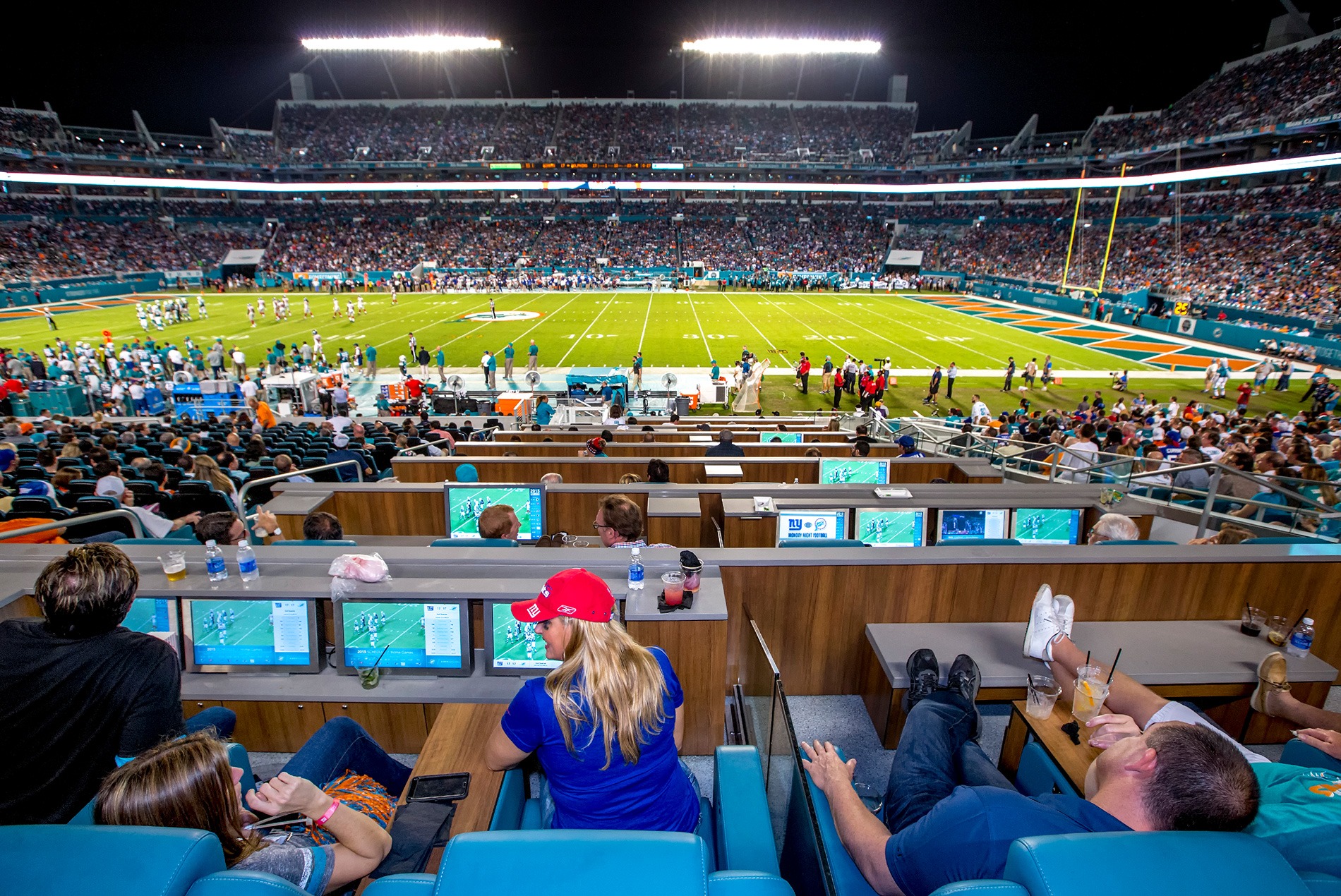
Living room boxes at Miami’s Hard Rock Stadium are integrated into the seating bowl, giving fans a unique premium experience while keeping them connected to the game.
Which innovative technologies are you incorporating in your design process?
Tyler: We use a combination of virtual and augmented reality tools alongside 2-D section drawings to immerse ourselves and our clients in a 3-D environment. Our studio has created a specific parametric design tool for developing seating bowls for a variety of sports. This tool enables us to modify different parameters, visually represent the changes and quickly evaluate a design.
Using this technology, we can position clients in a seat and demonstrate their sightlines, proximity to the field and positioning within the larger context of the stadium, ballpark or arena. The tool also allows us to instantly explore the implications of different strategies, like adjusting the elevation of the first row for an American football stadium.
Jon: A strong knowledge base still is a prerequisite for using these technologies effectively. Someone who doesn’t have experience with seating bowl design could make numerous iterations without achieving a helpful result.
How does designing for TV viewers in mind shape your process?
Tyler: Because so many fans watch games on their screens, optimizing the TV experience is a big deal. For a Diamond Club expansion at the Seattle Mariners’ T-Mobile Park, one goal was to enhance this at-home experience. By making minor changes like centering the outfield camera in a new penthouse and replacing the unappealing green wall behind home plate with a brick and stone one adorned with cast logos and neatly arranged ad boards, we enhanced the viewing experience. Even minor changes can improve the venue’s appeal for TV audiences and create a more memorable and distinct sense of place for viewers.
Jon: Designing with TV viewers in mind can be more challenging for sports like soccer and football, where the camera angles often only capture a small portion of the seating area. We always strive to design the seating bowl to be unique and recognizable when viewed from the center of the field.
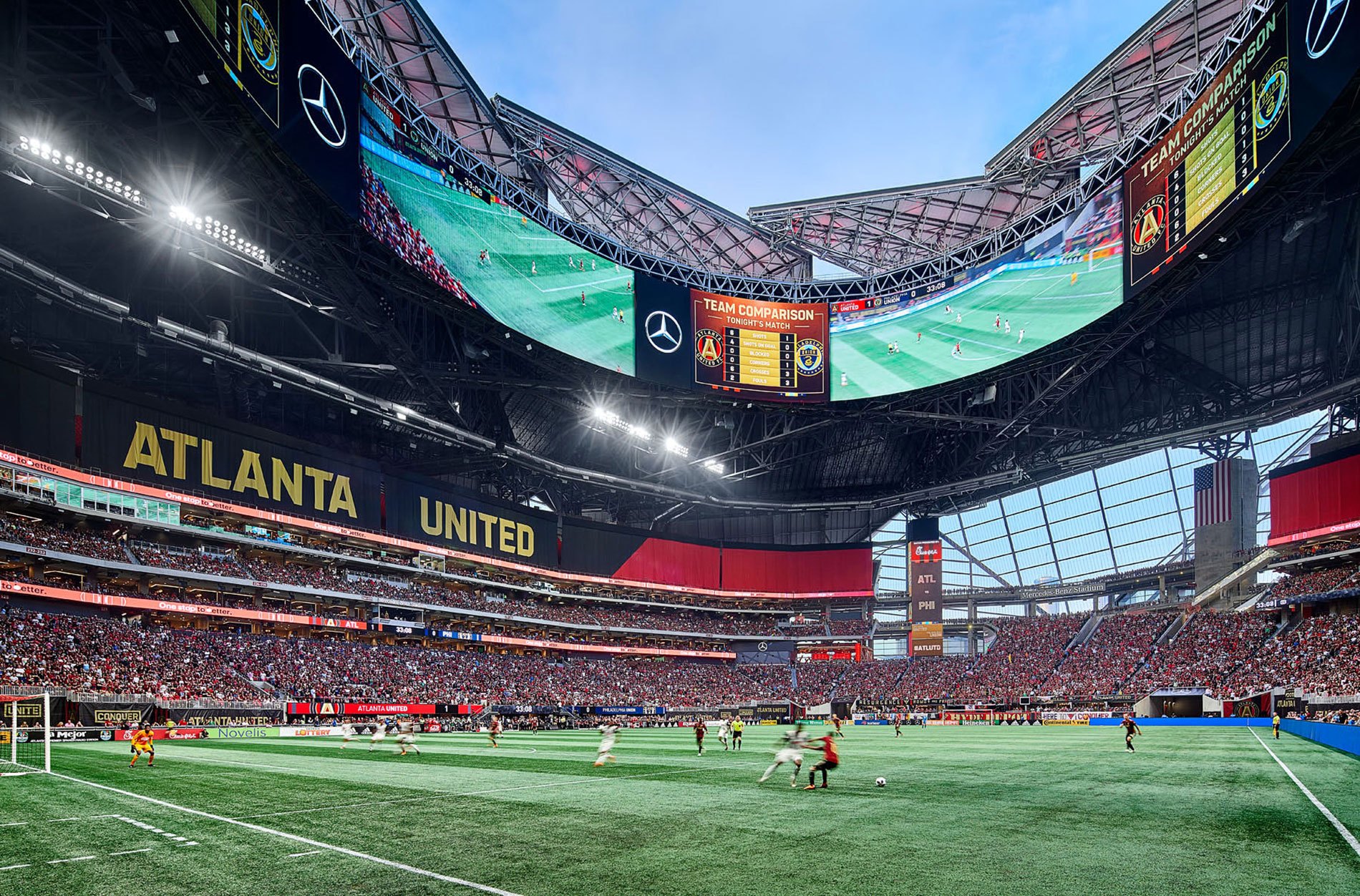
The seating bowl at Atlanta’s Mercedes-Benz Stadium adapts to accommodate a slightly smaller capacity for soccer by using a scrim in the upper bowl.
What’s it like being in a seating bowl of a project you’ve designed?
Jon: There’s a profound sense of gratification when we get positive feedback from clients. It serves as validation of the thought and care we put into it. And it feels good to see our vision become a reality.
Tyler: It’s incredible to be in a seating bowl filled with people enjoying themselves. Our ultimate goal is to create spaces where people can come together and have a great time. Experiencing the energy and intimacy of a sold-out Energizer Park in St. Louis has been a highlight of my career. The compactness and intensity of the environment in a soccer stadium like this are unparalleled.
Even so, every time I attend an opening of a stadium I’ve worked on, I find myself wondering what we can do better on the next project. That’s a never-ending quest that fuels our team.
Energizer Park was previously known as CITYPARK.
